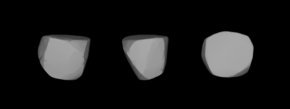Main-belt asteroid
68 Leto is a large main belt asteroid that is orbiting the Sun . The asteroid was discovered by German astronomer Robert Luther on April 29, 1861, and is named after Leto , the mother of Apollo and Artemis in Greek mythology . It orbits at a distance of 2.78112 AU over 4.64 years and has an orbital eccentricity of 0.187. The orbital plane is inclined at an angle of 7.97° to the ecliptic .[ 4]
Photometric observations of 68 Leto during 1997 provided a rotation period of 14.856 ± 0.024 h.[ 7] S , suggesting a stony, silicate composition.
References
^ "Leto" . Lexico UK English DictionaryOxford University Press . Archived from the original on 22 March 2020.^ E. Alan Roberts (2013) The Courage of Innocence: (The Virgin of Phileros) , p. 191
^ Greek Λητῷος – Lētōi-os Liddell, Henry George ; Scott, Robert ; A Greek–English Lexicon Perseus Project
^ a b c d "68 Leto" . JPL Small-Body Database NASA /Jet Propulsion Laboratory . Retrieved 12 May 2016 .^ a b c Carry, B. (December 2012), "Density of asteroids", Planetary and Space Science , 73 (1): 98– 118, arXiv :1203.4336 Bibcode :2012P&SS...73...98C , doi :10.1016/j.pss.2012.03.009 , S2CID 119226456 . ^ "Asteroid Data Sets" . Archived from the original on 17 December 2009. Retrieved 13 January 2007 .^ López-González, M. J.; Rodríguez, E. (September 2005), "Lightcurves and poles of seven asteroids", Planetary and Space Science , 53 (11): 1147– 1165, Bibcode :2005P&SS...53.1147L , doi :10.1016/j.pss.2005.04.010
External links
